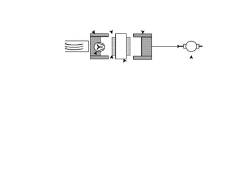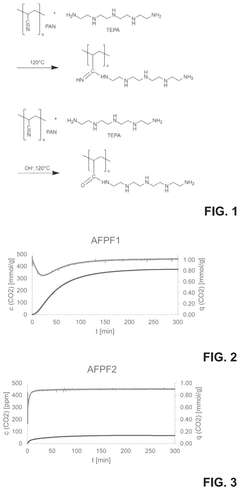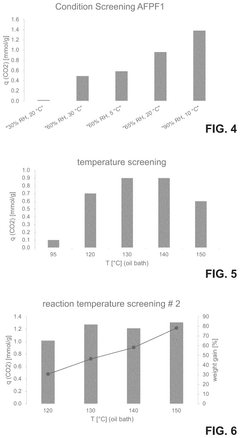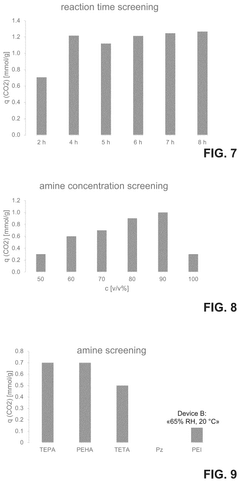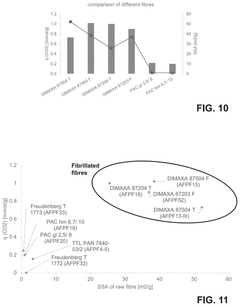How to Evaluate Amine-Functionalized Solid Sorbents for DAC: Bench Protocols and Key Metrics
AUG 21, 20259 MIN READ
Generate Your Research Report Instantly with AI Agent
Patsnap Eureka helps you evaluate technical feasibility & market potential.
DAC Sorbent Evaluation Background and Objectives
Direct Air Capture (DAC) technology has emerged as a promising solution to combat climate change by removing carbon dioxide directly from the atmosphere. As global efforts to reduce greenhouse gas emissions intensify, the development of efficient and cost-effective DAC systems has become a critical area of research and innovation. Among various DAC approaches, amine-functionalized solid sorbents have shown significant potential due to their high CO2 selectivity and capacity.
The evaluation of amine-functionalized solid sorbents for DAC applications is a complex process that requires careful consideration of multiple factors. The primary objective of this technical research is to establish standardized bench protocols and identify key metrics for assessing the performance and viability of these sorbents. By developing a comprehensive evaluation framework, researchers and industry professionals can make informed decisions about the most promising sorbent materials and accelerate the development of DAC technologies.
The evolution of DAC technology has been driven by the urgent need to mitigate climate change and achieve negative emissions. Early DAC systems faced challenges related to high energy consumption and low CO2 capture efficiency. However, recent advancements in materials science and process engineering have led to significant improvements in sorbent performance and overall system efficiency.
Amine-functionalized solid sorbents represent a class of materials that have gained considerable attention in the DAC field. These sorbents typically consist of a porous support material, such as silica or polymers, functionalized with various amine groups. The amine groups act as active sites for CO2 capture, forming reversible chemical bonds with CO2 molecules. The key advantages of amine-functionalized sorbents include their high selectivity for CO2, relatively low regeneration energy requirements, and potential for long-term stability.
The technical goals of this research include developing standardized protocols for bench-scale evaluation of amine-functionalized solid sorbents, identifying and quantifying key performance metrics, and establishing a framework for comparing different sorbent materials. These protocols and metrics will enable researchers to assess critical parameters such as CO2 capture capacity, adsorption kinetics, regeneration efficiency, and long-term stability under realistic DAC conditions.
Furthermore, this research aims to address the challenges associated with scaling up DAC technologies from laboratory experiments to pilot-scale and commercial applications. By establishing robust evaluation methods, the industry can better predict the performance of sorbents in large-scale systems and identify potential bottlenecks in the commercialization process.
The evaluation of amine-functionalized solid sorbents for DAC applications is a complex process that requires careful consideration of multiple factors. The primary objective of this technical research is to establish standardized bench protocols and identify key metrics for assessing the performance and viability of these sorbents. By developing a comprehensive evaluation framework, researchers and industry professionals can make informed decisions about the most promising sorbent materials and accelerate the development of DAC technologies.
The evolution of DAC technology has been driven by the urgent need to mitigate climate change and achieve negative emissions. Early DAC systems faced challenges related to high energy consumption and low CO2 capture efficiency. However, recent advancements in materials science and process engineering have led to significant improvements in sorbent performance and overall system efficiency.
Amine-functionalized solid sorbents represent a class of materials that have gained considerable attention in the DAC field. These sorbents typically consist of a porous support material, such as silica or polymers, functionalized with various amine groups. The amine groups act as active sites for CO2 capture, forming reversible chemical bonds with CO2 molecules. The key advantages of amine-functionalized sorbents include their high selectivity for CO2, relatively low regeneration energy requirements, and potential for long-term stability.
The technical goals of this research include developing standardized protocols for bench-scale evaluation of amine-functionalized solid sorbents, identifying and quantifying key performance metrics, and establishing a framework for comparing different sorbent materials. These protocols and metrics will enable researchers to assess critical parameters such as CO2 capture capacity, adsorption kinetics, regeneration efficiency, and long-term stability under realistic DAC conditions.
Furthermore, this research aims to address the challenges associated with scaling up DAC technologies from laboratory experiments to pilot-scale and commercial applications. By establishing robust evaluation methods, the industry can better predict the performance of sorbents in large-scale systems and identify potential bottlenecks in the commercialization process.
Market Analysis for DAC Technologies
The Direct Air Capture (DAC) technology market is experiencing significant growth and attracting substantial investments due to its potential to address climate change by removing carbon dioxide directly from the atmosphere. The global DAC market is projected to expand rapidly in the coming years, driven by increasing environmental concerns and stringent regulations aimed at reducing greenhouse gas emissions.
Currently, the DAC market is relatively small but is expected to grow exponentially as the technology matures and becomes more cost-effective. Several factors contribute to the increasing demand for DAC technologies, including the urgent need to achieve net-zero emissions targets, the limitations of natural carbon sinks, and the potential for negative emissions to offset hard-to-abate sectors.
The market for DAC technologies can be segmented based on the end-use applications of the captured CO2. These applications include enhanced oil recovery, food and beverage production, synthetic fuel manufacturing, and geological storage. Each of these segments presents unique opportunities and challenges for DAC technology providers.
Geographically, North America and Europe are leading the DAC market, with significant research and development activities and pilot projects underway. However, emerging economies in Asia-Pacific and Latin America are also showing increasing interest in DAC technologies as part of their climate mitigation strategies.
Key market drivers include government support through policies and incentives, corporate commitments to carbon neutrality, and the potential for carbon credit generation. The voluntary carbon market, in particular, is expected to play a crucial role in scaling up DAC technologies by providing a financial mechanism for offsetting emissions.
Despite the promising outlook, the DAC market faces several challenges. The high cost of carbon capture and energy requirements remain significant barriers to widespread adoption. Additionally, the lack of standardized evaluation metrics and protocols for assessing the performance of different DAC technologies, including amine-functionalized solid sorbents, poses challenges for market growth and investor confidence.
To address these challenges and capitalize on market opportunities, industry stakeholders are focusing on technological innovations to improve efficiency and reduce costs. Collaborations between technology developers, academic institutions, and industrial partners are becoming increasingly common to accelerate the commercialization of DAC technologies.
As the market evolves, there is a growing need for standardized bench protocols and key metrics to evaluate the performance of amine-functionalized solid sorbents and other DAC technologies. This standardization will be crucial for comparing different solutions, guiding investment decisions, and ensuring the scalability and reliability of DAC systems in real-world applications.
Currently, the DAC market is relatively small but is expected to grow exponentially as the technology matures and becomes more cost-effective. Several factors contribute to the increasing demand for DAC technologies, including the urgent need to achieve net-zero emissions targets, the limitations of natural carbon sinks, and the potential for negative emissions to offset hard-to-abate sectors.
The market for DAC technologies can be segmented based on the end-use applications of the captured CO2. These applications include enhanced oil recovery, food and beverage production, synthetic fuel manufacturing, and geological storage. Each of these segments presents unique opportunities and challenges for DAC technology providers.
Geographically, North America and Europe are leading the DAC market, with significant research and development activities and pilot projects underway. However, emerging economies in Asia-Pacific and Latin America are also showing increasing interest in DAC technologies as part of their climate mitigation strategies.
Key market drivers include government support through policies and incentives, corporate commitments to carbon neutrality, and the potential for carbon credit generation. The voluntary carbon market, in particular, is expected to play a crucial role in scaling up DAC technologies by providing a financial mechanism for offsetting emissions.
Despite the promising outlook, the DAC market faces several challenges. The high cost of carbon capture and energy requirements remain significant barriers to widespread adoption. Additionally, the lack of standardized evaluation metrics and protocols for assessing the performance of different DAC technologies, including amine-functionalized solid sorbents, poses challenges for market growth and investor confidence.
To address these challenges and capitalize on market opportunities, industry stakeholders are focusing on technological innovations to improve efficiency and reduce costs. Collaborations between technology developers, academic institutions, and industrial partners are becoming increasingly common to accelerate the commercialization of DAC technologies.
As the market evolves, there is a growing need for standardized bench protocols and key metrics to evaluate the performance of amine-functionalized solid sorbents and other DAC technologies. This standardization will be crucial for comparing different solutions, guiding investment decisions, and ensuring the scalability and reliability of DAC systems in real-world applications.
Current Challenges in Amine-Functionalized Sorbents
Amine-functionalized solid sorbents for Direct Air Capture (DAC) face several significant challenges that hinder their widespread adoption and efficiency. One of the primary issues is the degradation of sorbent materials over time, which reduces their CO2 capture capacity and overall performance. This degradation is often caused by exposure to contaminants in the air, such as SOx and NOx, as well as the repeated thermal cycling required for regeneration.
Another major challenge is the energy intensity of the regeneration process. The high temperatures needed to release captured CO2 from the sorbents result in substantial energy consumption, which can offset the environmental benefits of carbon capture. Developing more energy-efficient regeneration methods or sorbents that can release CO2 at lower temperatures is crucial for improving the overall sustainability of DAC systems.
The selectivity of amine-functionalized sorbents for CO2 over other atmospheric gases also presents a challenge. While these sorbents generally have a high affinity for CO2, improving their selectivity could enhance capture efficiency and reduce the energy required for separation of captured gases.
Scalability remains a significant hurdle for amine-functionalized sorbents in DAC applications. Current materials and processes often face difficulties when scaled up from laboratory to industrial levels, particularly in maintaining consistent performance and managing costs. The development of sorbents that can be easily manufactured and deployed at large scales is essential for the widespread implementation of DAC technology.
Water management is another critical challenge. Many amine-functionalized sorbents are hydrophilic and can absorb significant amounts of water from the air along with CO2. This not only affects the CO2 capture capacity but also complicates the regeneration process and can lead to increased energy consumption.
The long-term stability and recyclability of sorbents are also areas of concern. Ensuring that amine-functionalized materials can withstand numerous adsorption-desorption cycles without significant loss of performance is crucial for the economic viability of DAC systems. This includes maintaining structural integrity, preventing amine leaching, and resisting chemical changes that could reduce CO2 capture efficiency over time.
Lastly, the environmental impact of sorbent production and disposal needs to be carefully considered. Developing sustainable manufacturing processes and end-of-life strategies for these materials is essential to ensure that the overall carbon footprint of DAC technology remains negative.
Another major challenge is the energy intensity of the regeneration process. The high temperatures needed to release captured CO2 from the sorbents result in substantial energy consumption, which can offset the environmental benefits of carbon capture. Developing more energy-efficient regeneration methods or sorbents that can release CO2 at lower temperatures is crucial for improving the overall sustainability of DAC systems.
The selectivity of amine-functionalized sorbents for CO2 over other atmospheric gases also presents a challenge. While these sorbents generally have a high affinity for CO2, improving their selectivity could enhance capture efficiency and reduce the energy required for separation of captured gases.
Scalability remains a significant hurdle for amine-functionalized sorbents in DAC applications. Current materials and processes often face difficulties when scaled up from laboratory to industrial levels, particularly in maintaining consistent performance and managing costs. The development of sorbents that can be easily manufactured and deployed at large scales is essential for the widespread implementation of DAC technology.
Water management is another critical challenge. Many amine-functionalized sorbents are hydrophilic and can absorb significant amounts of water from the air along with CO2. This not only affects the CO2 capture capacity but also complicates the regeneration process and can lead to increased energy consumption.
The long-term stability and recyclability of sorbents are also areas of concern. Ensuring that amine-functionalized materials can withstand numerous adsorption-desorption cycles without significant loss of performance is crucial for the economic viability of DAC systems. This includes maintaining structural integrity, preventing amine leaching, and resisting chemical changes that could reduce CO2 capture efficiency over time.
Lastly, the environmental impact of sorbent production and disposal needs to be carefully considered. Developing sustainable manufacturing processes and end-of-life strategies for these materials is essential to ensure that the overall carbon footprint of DAC technology remains negative.
Existing Bench Protocols for Sorbent Evaluation
01 Adsorption capacity measurement
Evaluation of amine-functionalized solid sorbents often involves measuring their adsorption capacity for target gases, such as CO2. This metric quantifies the amount of gas that can be captured per unit mass or volume of the sorbent material. Adsorption isotherms and breakthrough curves are commonly used to determine the capacity under various conditions.- Adsorption capacity measurement: Evaluation of amine-functionalized solid sorbents often involves measuring their adsorption capacity for target gases such as CO2. This metric quantifies the amount of gas that can be captured per unit mass or volume of the sorbent material. Adsorption isotherms and breakthrough curves are commonly used to determine the capacity under various conditions.
- Selectivity and separation efficiency: The ability of amine-functionalized sorbents to selectively adsorb specific gases from mixtures is a crucial evaluation metric. This includes measuring the separation efficiency and selectivity factors for target gases over other components in flue gas or industrial streams. Higher selectivity indicates better performance in gas separation applications.
- Regeneration and cyclic stability: Assessing the regeneration efficiency and cyclic stability of amine-functionalized sorbents is essential for their practical application. This involves measuring the working capacity over multiple adsorption-desorption cycles, evaluating the energy required for regeneration, and determining the long-term stability of the sorbent material under repeated use.
- Kinetics and mass transfer properties: Evaluation of the adsorption kinetics and mass transfer properties of amine-functionalized sorbents is crucial for understanding their performance in dynamic systems. This includes measuring the rate of adsorption, diffusion coefficients, and mass transfer limitations within the porous structure of the sorbent material.
- Physical and chemical characterization: Comprehensive characterization of amine-functionalized solid sorbents involves evaluating their physical and chemical properties. This includes measuring surface area, pore size distribution, amine loading, thermal stability, and chemical composition. These characteristics are essential for understanding the structure-property relationships and optimizing sorbent performance.
02 Selectivity and separation efficiency
The ability of amine-functionalized sorbents to selectively adsorb specific gases from mixtures is a crucial evaluation metric. This includes measuring the separation efficiency and selectivity factors for target gases over other components in flue gas or industrial streams. Higher selectivity indicates better performance in gas separation applications.Expand Specific Solutions03 Regeneration and cyclic stability
Assessing the regeneration efficiency and cyclic stability of amine-functionalized sorbents is essential for their practical application. This involves evaluating the sorbent's performance over multiple adsorption-desorption cycles, measuring any loss in capacity or structural changes, and determining the energy requirements for regeneration.Expand Specific Solutions04 Kinetics and mass transfer properties
The adsorption and desorption kinetics of amine-functionalized sorbents are important evaluation metrics. This includes measuring the rate of gas uptake, diffusion coefficients, and mass transfer limitations. Faster kinetics and improved mass transfer properties are desirable for efficient gas capture and separation processes.Expand Specific Solutions05 Thermal and chemical stability
Evaluating the thermal and chemical stability of amine-functionalized sorbents is crucial for their long-term performance. This involves assessing the sorbent's resistance to degradation under various operating conditions, including high temperatures, presence of contaminants, and exposure to moisture. Stability tests help determine the sorbent's lifetime and suitability for specific applications.Expand Specific Solutions
Key Players in DAC Sorbent Development
The direct air capture (DAC) technology for amine-functionalized solid sorbents is in an early development stage, with a growing market driven by increasing focus on carbon dioxide removal. The competitive landscape is characterized by a mix of established companies and innovative startups. Key players like Climeworks AG and Global Thermostat LLC are advancing commercial-scale DAC plants, while research institutions such as Georgia Tech and Caltech are contributing to technological advancements. The industry is seeing collaborations between academia and industry to improve sorbent performance, process efficiency, and cost-effectiveness. As the technology matures, competition is expected to intensify, with companies striving to optimize their proprietary sorbent formulations and system designs.
Climeworks AG
Technical Solution: Climeworks has developed a Direct Air Capture (DAC) technology using amine-functionalized solid sorbents. Their approach involves modular CO2 collectors with a two-step process: adsorption of CO2 from air onto the sorbent, followed by desorption using low-grade heat (80-100°C) [1]. The company employs a proprietary amine-based filter material that selectively captures CO2. Their evaluation metrics include CO2 capture capacity, regeneration efficiency, and long-term stability of the sorbent. Climeworks has also focused on optimizing the energy consumption of their process, achieving significant improvements in recent years [2].
Strengths: Modular and scalable design, low-temperature regeneration, commercially deployed. Weaknesses: High initial costs, energy-intensive process compared to natural solutions.
Global Thermostat LLC
Technical Solution: Global Thermostat has pioneered a unique amine-based DAC technology using a honeycomb-structured monolith as the support for their amine sorbents. Their evaluation protocols focus on the CO2 adsorption capacity, cyclic stability, and regeneration energy requirements. The company's bench-scale testing involves precise control of temperature, humidity, and gas flow rates to simulate real-world conditions [3]. They have reported achieving CO2 capture costs below $100 per ton, significantly lower than many competitors [4]. Global Thermostat's key metrics include the CO2 loading capacity of the sorbent, the number of adsorption-desorption cycles before performance degradation, and the energy consumption per ton of CO2 captured.
Strengths: High CO2 selectivity, low regeneration temperature, potential for integration with existing industrial processes. Weaknesses: Scalability challenges, sensitivity to moisture in air.
Critical Metrics for DAC Sorbent Performance
Apparatus, method and system for direct air capture utilizing electromagnetic excitation radiation desorption of solid amine sorbents to release carbon dioxide
PatentPendingIN202317002491A
Innovation
- The use of polyamine sorbents, specifically polyethylenimine (PEI), in conjunction with microwave (MW) or radio frequency (RF) irradiation for carbon dioxide capture and regeneration, employing laminar-flow contactors and a desorption mechanism that minimizes energy consumption and extends sorbent lifespan, optimizing the desorption process through controlled MW energy usage.
Amine functionalized fibres for direct air capture
PatentPendingUS20240335816A1
Innovation
- The method involves producing amine functionalized polyacrylonitrile (PAN) fibers by reacting pristine PAN fibers with tetraethylenepentamine (TEPA) or pentaethylenehexamine at elevated temperatures, creating a high-surface-area sorbent with enhanced CO2 capture capacity and stability, which can be processed into structured adsorber elements for direct air capture.
Environmental Impact Assessment of DAC Sorbents
The environmental impact assessment of Direct Air Capture (DAC) sorbents is a critical aspect of evaluating the overall sustainability and feasibility of amine-functionalized solid sorbents for carbon dioxide removal. This assessment encompasses various factors, including energy consumption, resource utilization, and potential ecological effects throughout the sorbent lifecycle.
One of the primary considerations is the energy intensity of the DAC process using amine-functionalized solid sorbents. The regeneration of these sorbents typically requires significant thermal energy input, which can lead to substantial greenhouse gas emissions if not sourced from renewable energy. Evaluating the energy efficiency of different sorbent materials and regeneration processes is crucial for minimizing the carbon footprint of DAC operations.
Water consumption is another key environmental factor to assess. Some amine-functionalized sorbents may require water for the CO2 capture process or for cooling during regeneration. In water-stressed regions, this could pose significant environmental challenges. Quantifying water usage and exploring water-efficient sorbent designs are essential steps in the environmental impact assessment.
The production and disposal of amine-functionalized solid sorbents also warrant careful examination. The synthesis of these materials often involves chemical processes that may generate hazardous waste or emissions. Assessing the environmental impact of sorbent manufacturing, including raw material extraction and processing, is crucial for a comprehensive lifecycle analysis.
Potential air and water pollution risks associated with DAC operations using amine-functionalized sorbents must be evaluated. This includes the possibility of amine emissions or leaching, which could have localized environmental impacts. Developing protocols for monitoring and mitigating these risks is an important aspect of the environmental assessment.
Land use implications of large-scale DAC deployment with solid sorbents should also be considered. While generally less land-intensive than some other carbon removal approaches, the spatial requirements for DAC facilities and their potential impact on local ecosystems and biodiversity need to be carefully assessed.
The durability and recyclability of amine-functionalized solid sorbents play a significant role in their long-term environmental impact. Sorbents with longer lifespans and the potential for recycling or repurposing at end-of-life can significantly reduce waste generation and the need for frequent replacements, thereby minimizing overall environmental footprint.
Lastly, the assessment should consider the potential for environmental benefits resulting from successful CO2 removal. This includes evaluating the net carbon reduction achieved by DAC operations using amine-functionalized sorbents, taking into account the emissions associated with their production, operation, and disposal.
One of the primary considerations is the energy intensity of the DAC process using amine-functionalized solid sorbents. The regeneration of these sorbents typically requires significant thermal energy input, which can lead to substantial greenhouse gas emissions if not sourced from renewable energy. Evaluating the energy efficiency of different sorbent materials and regeneration processes is crucial for minimizing the carbon footprint of DAC operations.
Water consumption is another key environmental factor to assess. Some amine-functionalized sorbents may require water for the CO2 capture process or for cooling during regeneration. In water-stressed regions, this could pose significant environmental challenges. Quantifying water usage and exploring water-efficient sorbent designs are essential steps in the environmental impact assessment.
The production and disposal of amine-functionalized solid sorbents also warrant careful examination. The synthesis of these materials often involves chemical processes that may generate hazardous waste or emissions. Assessing the environmental impact of sorbent manufacturing, including raw material extraction and processing, is crucial for a comprehensive lifecycle analysis.
Potential air and water pollution risks associated with DAC operations using amine-functionalized sorbents must be evaluated. This includes the possibility of amine emissions or leaching, which could have localized environmental impacts. Developing protocols for monitoring and mitigating these risks is an important aspect of the environmental assessment.
Land use implications of large-scale DAC deployment with solid sorbents should also be considered. While generally less land-intensive than some other carbon removal approaches, the spatial requirements for DAC facilities and their potential impact on local ecosystems and biodiversity need to be carefully assessed.
The durability and recyclability of amine-functionalized solid sorbents play a significant role in their long-term environmental impact. Sorbents with longer lifespans and the potential for recycling or repurposing at end-of-life can significantly reduce waste generation and the need for frequent replacements, thereby minimizing overall environmental footprint.
Lastly, the assessment should consider the potential for environmental benefits resulting from successful CO2 removal. This includes evaluating the net carbon reduction achieved by DAC operations using amine-functionalized sorbents, taking into account the emissions associated with their production, operation, and disposal.
Scalability and Cost Analysis of DAC Technologies
The scalability and cost analysis of Direct Air Capture (DAC) technologies is crucial for evaluating their potential for large-scale implementation in addressing climate change. As amine-functionalized solid sorbents emerge as promising materials for DAC, understanding their economic viability and scalability becomes paramount.
Current DAC technologies face significant challenges in terms of scalability. The process of capturing CO2 from ambient air requires substantial energy input and large volumes of air to be processed. Scaling up these systems to capture meaningful amounts of CO2 necessitates careful consideration of land use, energy consumption, and infrastructure requirements. The physical footprint of DAC plants using amine-functionalized solid sorbents must be optimized to balance capture efficiency with practical deployment constraints.
Cost analysis of DAC technologies reveals that they are currently more expensive than many other carbon mitigation strategies. The levelized cost of carbon dioxide removal (LCDR) for DAC systems ranges from $100 to $1000 per ton of CO2, depending on the specific technology and scale of operation. Amine-functionalized solid sorbents show promise in potentially reducing these costs due to their high selectivity for CO2 and relatively low regeneration energy requirements.
Key factors influencing the economics of DAC include energy costs, sorbent efficiency and longevity, and capital expenditures for equipment and infrastructure. The energy intensity of the capture and regeneration processes significantly impacts operational expenses. Improving the CO2 uptake capacity and cycling stability of amine-functionalized sorbents can lead to substantial cost reductions by increasing the amount of CO2 captured per unit of energy consumed.
To assess the scalability of amine-functionalized solid sorbents for DAC, it is essential to consider their production at industrial scales. The synthesis and functionalization processes must be amenable to large-scale manufacturing without compromising material performance. Additionally, the environmental impact and sustainability of sorbent production should be evaluated to ensure that the overall carbon footprint of the DAC process remains negative.
Economic modeling of DAC systems using amine-functionalized solid sorbents should account for potential improvements in technology and economies of scale. As the technology matures and deployment increases, costs are expected to decrease. However, the rate of cost reduction and the ultimate floor price for DAC remain subjects of debate and ongoing research. Sensitivity analyses can help identify the most critical parameters for cost reduction and guide research and development efforts.
Current DAC technologies face significant challenges in terms of scalability. The process of capturing CO2 from ambient air requires substantial energy input and large volumes of air to be processed. Scaling up these systems to capture meaningful amounts of CO2 necessitates careful consideration of land use, energy consumption, and infrastructure requirements. The physical footprint of DAC plants using amine-functionalized solid sorbents must be optimized to balance capture efficiency with practical deployment constraints.
Cost analysis of DAC technologies reveals that they are currently more expensive than many other carbon mitigation strategies. The levelized cost of carbon dioxide removal (LCDR) for DAC systems ranges from $100 to $1000 per ton of CO2, depending on the specific technology and scale of operation. Amine-functionalized solid sorbents show promise in potentially reducing these costs due to their high selectivity for CO2 and relatively low regeneration energy requirements.
Key factors influencing the economics of DAC include energy costs, sorbent efficiency and longevity, and capital expenditures for equipment and infrastructure. The energy intensity of the capture and regeneration processes significantly impacts operational expenses. Improving the CO2 uptake capacity and cycling stability of amine-functionalized sorbents can lead to substantial cost reductions by increasing the amount of CO2 captured per unit of energy consumed.
To assess the scalability of amine-functionalized solid sorbents for DAC, it is essential to consider their production at industrial scales. The synthesis and functionalization processes must be amenable to large-scale manufacturing without compromising material performance. Additionally, the environmental impact and sustainability of sorbent production should be evaluated to ensure that the overall carbon footprint of the DAC process remains negative.
Economic modeling of DAC systems using amine-functionalized solid sorbents should account for potential improvements in technology and economies of scale. As the technology matures and deployment increases, costs are expected to decrease. However, the rate of cost reduction and the ultimate floor price for DAC remain subjects of debate and ongoing research. Sensitivity analyses can help identify the most critical parameters for cost reduction and guide research and development efforts.
Unlock deeper insights with Patsnap Eureka Quick Research — get a full tech report to explore trends and direct your research. Try now!
Generate Your Research Report Instantly with AI Agent
Supercharge your innovation with Patsnap Eureka AI Agent Platform!



